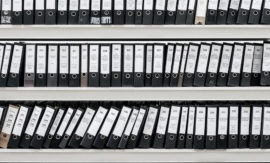Intended learning outcomes: Present the concepts of the bill of material, of the bill-of-material position, and the where-used list.
By way of example, Figure 1.2.2.2 shows a bill of material, that is, a convergent product structure with two structure levels. The conventional method used to model the bill-of-material business object does not represent the object as a whole. Instead, it defines a detailed logistical object for that business object.
A bill-of-material position is a product <-> component connection within a bill of material.
Here is an example. Figure 17.2.3.1 contains five items — the three components x, y, and z, each of which occurs in products 1 and 2.
Fig. 17.2.3.1 Representation of two bills of material, each with three components.
The two bills of material lead to detailed objects, that is, six bill-of-material positions. These represent the six connections shown in Figure 17.2.3.2 from the product viewpoint and from the component viewpoint.
Fig. 17.2.3.2 Detailed logistical objects: the six bill-of-material positions as connections in two bills of material, each with three components.
Breaking down bills of material into their individual positions leads directly to further logistical objects. They are all derived from the bill-of-material positions by means of algorithms.
A where-used list indicates the way in which a component is used in different products, taking the structural levels into account (see Section 1.2.2).
The component viewpoint in Figure 17.2.3.2, that is, the bottom to top viewpoint in Figure 17.2.3.1, leads to three where-used lists — for the components x, y, and z, each with two uses in products 1 and 2.
Different forms of these bills of material and where-used lists are needed, depending on the application. Each “product « component” connection should only be defined or stored once, however. The only exception to this rule is for components that occur several times in the same product (but are different each time). These occurrences can be differentiated using a relative position number (see below).
Continuation in next subsection (17.2.3b).
Course section 17.2: Subsections and their intended learning outcomes

17.2 The Master Data for Products and Processes
Intended learning outcomes: Describe master data of products, components, and operations. Explain the data structure of item master, bill of material, and where-used list. Disclose the data structure of work center master data, the work center hierarchy, as well as for operation, routing sheet, production equipment, bill of production equipment, and bill of tools.

17.2.1 Product, Product Structure, Components, and Operations
Intended learning outcomes: Present the concept of master data. Explain the production order as a collection of master data. Describe a simple product structure.

17.2.1b The Intermediate Part
Intended learning outcomes: Identify the intermediate part used simultaneously as a component in higher-level products.

17.2.2 Item Master Data
Intended learning outcomes: Present the concept of the item master record. Describe the attributes of the technical information and the stockkeeping information of the item master record. Identify attributes of the item master record for information on costs and prices.

17.2.3a Bill of Material, Bill-of-Material Position, and Where-Used List
Intended learning outcomes: Present the concepts of the bill of material, of the bill-of-material position, and the where-used list.

17.2.3b Single-Level Bill of Material, Multilevel Bill of Material, and Summarized Bill of Material
Intended learning outcomes: Differentiate between the single-level bill of material, the multilevel bill of material, and the summarized bill of material.

17.2.3c Single-Level Where-Used List, Multilevel Where-Used List, and Summarized Where-Used List
Intended learning outcomes: Differentiate between the single-level where-used list, the multilevel where-used list, and the summarized where-used list.

17.2.3d The Bill-of-Material Position and the Where-Used-List Position as a Logistical Object
Describe the bill-of-material position and the where-used-list position as logistical objects. Identify its most important attributes.

17.2.4 Work Center Master Data
Intended learning outcomes: Present the work-center business object. Describe the attributes of the work-center master record relating to capacity, concerning costs, and for calculating the lead time.

17.2.5 The Work Center Hierarchy
Intended learning outcomes: Present the concepts of workstation and cost center. Explain the work center hierarchy.

17.2.6 Operation and Routing Sheet
Intended learning outcomes: Present the operation business object in association with the routing sheet. Describe its attributes. Identify the work center where-used list.

17.2.7 Production Equipment, Bill of Production Equipment, and Bill of Tools
Intended learning outcomes: Present the concepts of bill of production equipment and bill-of-production-equipment position as well as production equipment where-used list. Produce an overview on collective tool, bill of tools, bill-of-tools position, and tool where-used list.
